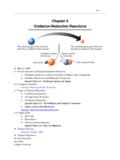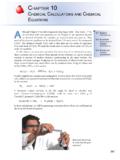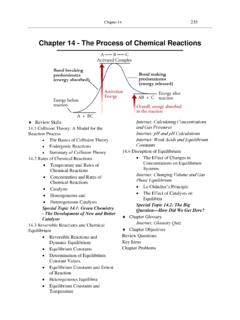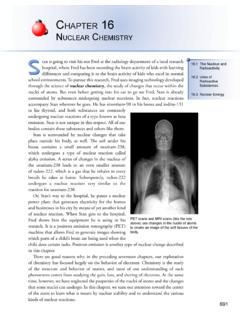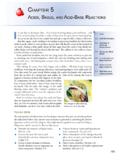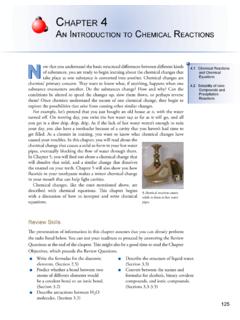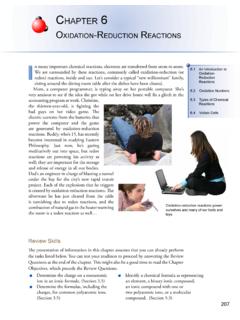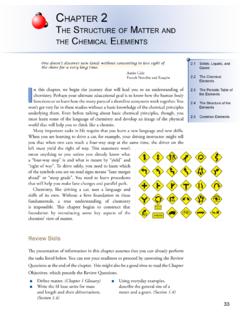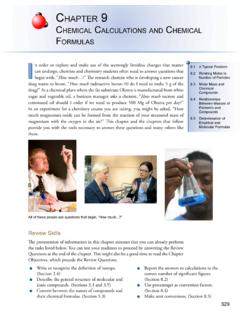Transcription of Chapter Unit Conversions - preparatorychemistry.com
1 Chapter 8 unit Conversions287ou may agree with Roger Bacon that mathematics is the easiest of sciences, but many beginning chemistry students would not. Because they have found mathematics challenging, they wish it were not so important for learning chemistry or for answering so many of the questions that arise in everyday life. They can better relate to Fran Lebowitz s advice in the second quotation. If you are one of the latter group, it will please you to know that even though there is some algebra in chemistry, this Chapter teaches a technique for doing chemical calculations (and many other calculations) without it. Although this technique has several common names, it is called unit analysis in this text.
2 You will be using it throughout the rest of this book, in future chemistry and science courses, and in fact, any time you want to calculate the number of nails you need to build a fence, or the number of rolls of paper you require to cover the kitchen unit Rounding Off and Significant Density and Density Percentage and Percentage A Summary of the unit Analysis Temperature Conversions List the metric units without prefixes and the corresponding abbreviations for length (meter, m), mass (gram, g), volume (liter, L), and energy (joule, J). (Section ) State the numbers or fractions represented by the following metric prefixes, and write their abbreviations: giga, mega, kilo, centi, milli, micro, nano, and pico. (Section ) Given a metric unit , write its abbreviation; given an abbreviation, write the full name of the unit .
3 (Section ) Describe the relationships between the metric units that do not have prefixes (such as meter, gram, and liter) and units derived from them by the addition of prefixes for example, 1 km = 103 m. (Section ) Describe the Celsius, Fahrenheit, and Kelvin scales used to report temperature values. (See Section ) Given a value derived from a measurement, identify the range of possible values it represents, on the basis of the assumption that its uncertainty is 1 in the last position reported. (For example, mL says the value could be from mL to mL.) (Section ) unit analysis, the technique for doing unit Conversions described in this Chapter , can be used for a lot more than chemical calculations.[M] is the easiest of sciences, a fact which is obvious in that no one s brain rejects Roger Bacon (c.)
4 1214-c. 1294), English philosopher and scientistStand firm in your refusal to remain conscious during algebra. In real life, I assure you, there is no such thing as algebra. Fran Lebowitz (b. 1951), American journalistReview SkillsThe presentation of information in this Chapter assumes that you can already perform the tasks listed below. You can test your readiness to proceed by answering the Review Questions at the end of the Chapter . This might also be a good time to read the Chapter Objectives, which precede the Review Questions. unit AnalysisMany of the questions asked in chemistry and in everyday life can be answered by converting one unit of measure into another. For example, suppose you are taking care of your nephew for the weekend, and he breaks his arm.
5 The doctor sets the arm, puts it in a cast, and prescribes an analgesic to help control the pain. Back at home, after filling the prescription, you realize that the label calls for 2 teaspoons of medicine every six hours, but the measuring device that the pharmacy gave you is calibrated in milliliters. You can t find a measuring teaspoon in your kitchen, so you ve got to figure out how many milliliters are equivalent to 2 tsp. It s been a rough day, there s a crying boy on the couch, and you re really tired. Is there a technique for doing the necessary calculation that is simple and reliable? unit analysis to the rescue! The main purpose of this Chapter is to show you how to make many different types of unit Conversions , such as the one required above. You will find that the stepwise thought process associated with the procedure called unit analysis1 not only guides you in figuring out how to set up unit conversion problems but also gives you confidence that your answers are correct.
6 an overview of the General ProcedureIn every affair, consider what precedes and follows, and then undertake (c. 55-c. 135) Greek PhilosopherYou will see many different types of unit Conversions in this Chapter , but they can all be worked using the same general procedure. To illustrate the process, we will convert 2 teaspoons to milliliters and solve the problem of how much medicine to give the little boy described above. The first step in the procedure is to identify the unit for the value we want to calculate. We write this on the left side of an equals sign. Next, we identify the value that we will convert into the desired value, and we write it on the right side of the equals sign. (Remember that a value constitutes both a number and a unit .) We want to know how many milliliters are equivalent to 2 tsp.
7 We express this question as? mL = 2 tsp Desired unitGiven unitNext, we multiply by one or more conversion factors that enable us to cancel the unwanted units and generate the desired units. A conversion factor is a ratio that describes the relationship between two units. To create a conversion factor for converting teaspoons to milliliters we can look in any modern cookbook (check its index under metric Conversions ) and discover that the relationship between teaspoons and milliliters is1 tsp = 5 mL1 unit analysis has other names, including the factor-label method, the conversion factor method, and dimensional analysis. 288 Chapter 8 unit unit Analysis 289objeCtive 2 This relationship can be used to produce two ratios, or conversion factors: 5 mL1 tsp5 mL1 tsporThe first of these can be used to convert teaspoons to milliliters, and the second can be used to convert milliliters to teaspoons.
8 The final step in the procedure is to multiply the known unit (2 tsp) by the proper conversion factor, the one that converts teaspoons to mL = 2 tsp = 10 mL 5 mL1 tspDesired unitGiven unitConversion factorAnswer with desired unitBecause 1 teaspoon is equivalent to 5 milliliters, multiplying by 5 mL/1 tsp is the same as multiplying by 1. The volume associated with 2 tsp does not change when we multiply by the conversion factor, but the value (number and unit ) does. Because one milliliter is one-fifth the volume of one teaspoon, there are five times as many milliliters for a given volume. Therefore, 2 tsp and 10 mL represent the same that the units in a unit analysis setup cancel just like variables in an algebraic equation. Therefore, when we want to convert tsp to mL, we choose the ratio that has tsp on the bottom to cancel the tsp unit in our original value and leave us with the desired unit of mL.
9 If you have used correct conversion factors, and if your units cancel to yield the desired unit or units, you can be confident that you will arrive at the correct answer. Metric Metric ConversionsAs you saw in Chapter 1, one of the convenient features of the metric system is that the relationships between metric units can be derived from the metric prefixes. These relationships can easily be translated into conversion factors. For example, milli- means 10-3 (or or 1/1000), so a milliliter (mL) is 10-3 liters (L). Thus there are 1000 or 103 milliliters in a liter. (A complete list of the prefixes that you need to know to solve the problems in this text is in Table ) Two possible sets of conversion factors for relating milliliters to liters can be obtained from these mL = 1 L leads to or103 mL1 L103 mL1 L1 mL = 10 3 L leads to or10 3 L1 mL10 3 L1 mLIn the remainder of this text, metric-metric conversion factors will have positive exponents like those found in the first set of conversion factors above.
10 ObjeCtive 2example - conversion FactorsWrite two conversion factors that relate nanometers and meters. Use positive exponents in each. SolutionNano- means 10-9, so nanometer means 10-9 nm = 10-9 m and 109 nm = 1 m Because we want our conversion factors to have positive exponents, we will build our ratios from the equation on the right (109 nm = 1 m):109 nm1 mor109 nm1 mobjeCtive 2exerCise - conversion Factors Write two conversion factors that relate the following pairs of metric units. Use positive exponents for each. a. joule and kilojouleb. meter and centimeterc. liter and gigaliterd. gram and micrograme. gram and megagramobjeCtive 2example - unit ConversionsConvert 365 nanometers to want the answer in kilometers (km), and the units we are given are nanometers (nm), so, we are converting from one metric length unit to another metric length unit .
